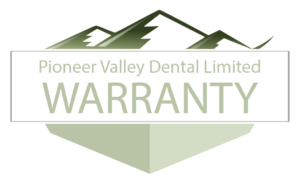Advanced Dentistry and Technology
When you walk into Pioneer Valley Dental you will notice two things, warm and friendly people and a technologically advanced practice.
Realizing that dentistry has simple and complex cases, we’re ready to treat you regardless of your needs. We offer services in dental implants, endodontics (root canals), orthodontics (Invisalign and braces), prosthodontics (replacing one, a few, or all teeth) and more. We’ve assembled a team that’s broad in talent and scope so your needs can be met in one location. You could be receiving a treatment in one chair while your child is getting his braces adjusted. That’s how broad our dental offering is. And we’ve invested in the latest technology to assure that your treatments are thorough and exceptional.
Dental Implants
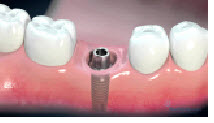 Dental implants are a permanent and appealing solution to replace missing or extracted teeth. They are better than other alternatives like bridges because no additional teeth need to be altered to place the new tooth. A single tooth implant is a one-tooth solution for a one-tooth problem.
Dental implants are a permanent and appealing solution to replace missing or extracted teeth. They are better than other alternatives like bridges because no additional teeth need to be altered to place the new tooth. A single tooth implant is a one-tooth solution for a one-tooth problem.
The entire implant process is performed over the course of a few months. The first part of the process is to place the implant itself into the jaw bone. Multiple implants can be placed at once if necessary.
The implant must be allowed about 3-6 months to heal, and during this time the jaw bone will form around the implant in a process called osseointegration. During this healing time you can have temporary crowns installed so that you can eat and speak normally and maintain a proper aesthetic appearance for your smile.
After the implant has healed it is time to place an abutment on the implant. The abutment serves as the base for your new tooth. Once this is placed an impression of the abutment is taken and is used to create your permanent restoration. Once the restoration is completed you can return to the office to attach the restoration permanently. Your smile will look just like it used to, and after a short period of getting used to the implant it will feel just like one of your own teeth..
TekScan T-Scan
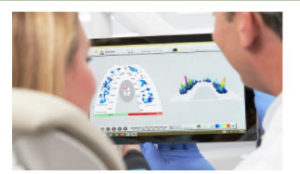 Amazing innovations are being developed and released in dentistry and we’re at the forefront with our investments in technology. Take TekScan’s T-Scan system for example. At Pioneer Valley Dental, we no longer use litmus to diagnose poor occlusion in your bite. Although it’s effective, it often times does not tell the whole story. With the T-Scan system we can look at data never seen before in dentistry.
Amazing innovations are being developed and released in dentistry and we’re at the forefront with our investments in technology. Take TekScan’s T-Scan system for example. At Pioneer Valley Dental, we no longer use litmus to diagnose poor occlusion in your bite. Although it’s effective, it often times does not tell the whole story. With the T-Scan system we can look at data never seen before in dentistry.
We are now able to see levels of force on each tooth and the amount of time that force is applied. Force impacts the integrity of the enamel of your teeth. It can be the causative factor behind of headaches, temporomandibular joint disorder (TMJ, TMD) and gum recession and sensitive teeth.
These issues will wreak havoc on your teeth causing cracks and premature enamel weakening from grinding and clinching. Our approach as a dental practice is to give you the best possible oral care and it reaches beyond to full mouth and jaw restoration.
3D Cone Beam Imaging
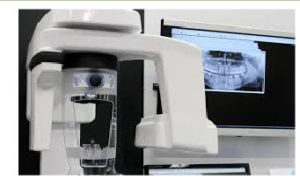 To better diagnose and understand more complicated cases, we have invested in Cone Beam Volumetric Tomography. That’s a mouthful but what we get from this amazing machine is a mouthful as well. Cone beam imaging works the same way that an x-ray works but it converts the 2D images into 3D by assembling hundreds of slices of data into one file through high-tech computer processing. We basically get a picture of your whole mouth from every angle. This enables us to diagnose issues more completely and helps increase the types of treatments that we provide with great precision. It’s particularly effective for dental implants, orthodontics, TMJ and endodontics (root canals). We can see fractured roots with much greater detail and it’s indispensible for knowing the mandibular nerve proximity for molar extraction and dental implants.
To better diagnose and understand more complicated cases, we have invested in Cone Beam Volumetric Tomography. That’s a mouthful but what we get from this amazing machine is a mouthful as well. Cone beam imaging works the same way that an x-ray works but it converts the 2D images into 3D by assembling hundreds of slices of data into one file through high-tech computer processing. We basically get a picture of your whole mouth from every angle. This enables us to diagnose issues more completely and helps increase the types of treatments that we provide with great precision. It’s particularly effective for dental implants, orthodontics, TMJ and endodontics (root canals). We can see fractured roots with much greater detail and it’s indispensible for knowing the mandibular nerve proximity for molar extraction and dental implants.
This highlights another area that we have made an investment to give you the best possible treatment under one roof.
Invisalign and Braces
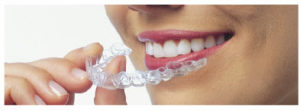 Invisalign is a new system of straightening teeth without the use of conventional braces. A series of clear plastic aligners are utilized to create tooth movement. Moving teeth with removable aligners is not new. However, the computer program, which can generate a series of aligners with small changes is the new part. Invisalign is recommended for orthodontic situations with mild to moderate spacing or crowding. They are virtually undetectable, easy to use and comfortable to wear.
Invisalign is a new system of straightening teeth without the use of conventional braces. A series of clear plastic aligners are utilized to create tooth movement. Moving teeth with removable aligners is not new. However, the computer program, which can generate a series of aligners with small changes is the new part. Invisalign is recommended for orthodontic situations with mild to moderate spacing or crowding. They are virtually undetectable, easy to use and comfortable to wear.
If you're looking for braces in Utah, Pionner Valley Dental can help! Our West Valley dentists are trained in both traditional and clear braces, and can help make your smile perfect.
You can read below about the types of braces Pioneer Valley Dental offers. If you have additional questions about finding braces in Utah, please call our office. Or, you can use the form found here. Don't wait any longer to find that perfect smile.
Traditional braces in Utah - Beyond their traditional color, the only thing traditional about these braces is that you can see them. Contemporary braces are made of super strong metal alloys derived from the space program. Their strength allows them to be the smallest of all braces and therefore the most comfortable. Their density makes them ultra slippery so teeth move faster than they ever have before. Today's braces, in combination with other high tech materials, mean fewer office visits to complete treatment.
Clear braces/Ceramic braces in Utah - Ceramic braces utilize less noticeable brackets for patients concerned about aesthetic appearances. Ceramic brackets are translucent, so they blend in with your natural tooth color. This means that unlike traditional stainless steel braces, with ceramic braces your smile will not look 'metallic.' In addition, ceramic brackets are designed so that they won't stain or discolor over long periods of time.
Root Canal (Endodontics)
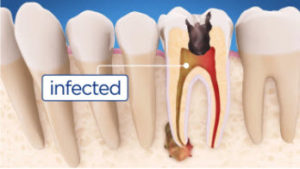 Endodontics is the dental specialty that deals with the nerves of the teeth. Root canals are probably the most notorious procedure in dentistry and the most common procedure relating to endodontics. When a tooth becomes infected it is usually related to the nerves and soft tissue in the root of the tooth. The infected tissue and nerves need to be removed. If left untreated an infection can turn into an abscess, which is a much more serious problem that includes bone loss in the jaw.
Endodontics is the dental specialty that deals with the nerves of the teeth. Root canals are probably the most notorious procedure in dentistry and the most common procedure relating to endodontics. When a tooth becomes infected it is usually related to the nerves and soft tissue in the root of the tooth. The infected tissue and nerves need to be removed. If left untreated an infection can turn into an abscess, which is a much more serious problem that includes bone loss in the jaw.
"Root canal" has become a scary term for dental patients to hear, but the benefits of the procedure and advances in dental technology have made it much less "scary". Local anesthetics and proper pain medication allow the procedure to be performed with little to no pain in most cases. There may be some soreness following the procedure, but that is normal for most dental procedures. Over the counter painkillers are usually enough to relieve any pain afterwards, but your dentist may prescribe medication. The procedure will also relieve you from pain caused by the infection allowing you to enjoy all the foods you love without any pain from hot things, or cold foods, or biting too hard. If you are experiencing pain, consult your dentist today.
Sinus Augmentation for Implants
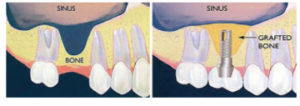 Loss of posterior teeth may result in excessive forces being placed on your remaining anterior teeth. Fortunately, the use of dental implants and crowns allow you to replace these missing teeth. However, the position of the sinus in the upper posterior areas may be too low for proper placement of dental implants.
Loss of posterior teeth may result in excessive forces being placed on your remaining anterior teeth. Fortunately, the use of dental implants and crowns allow you to replace these missing teeth. However, the position of the sinus in the upper posterior areas may be too low for proper placement of dental implants.
A simple procedure allows the sinus floor to be repositioned, creating enough space to properly place an implant. Various grafting materials are used to encourage your bone to grow more quickly into the area, helping to stabilize the dental implant.
Under certain conditions, an even simpler procedure can be utilized. When possible, the bone remaining under the sinus floor is gently “pushed up”, thus lifting the floor of the “dropped” sinus. Bone replacement materials are then placed beneath this lifted bone. Once again the bone materials are replaced as your body grow new bone into this area.
Sinus augmentation procedures are highly predictable, with studies reporting over 95% success. Following sufficient healing of a sinus augmentation (6-10 months), implants are placed in a predictable and successful manner.
Soft Tissue Grafting and Bone Grafting
A soft tissue graft is used when there has been a significant amount of gum recession in a particular area. Slight gum recession can usually be fixed with a few changes to your oral hygiene routine to take better care of your teeth and gums. When the gingiva recedes further it exposes you to greater risk for infection and bacterial penetration. You will likely be more sensitive to hot and cold foods when you have receding gums. If the gums recede enough as to expose the root you can set yourself up for more serious problems. The root is softer than the enamel making it more vulnerable to bacteria and plaque.
To restore proper gum level and functionality a soft tissue graft can be performed. This is done by either removing soft tissue from the roof of the mouth, or repositioning healthy gum tissue from adjacent teeth. This procedure is very predictable and has a high success rate. This procedure should be performed before more serious problems develop and more complex periodontal surgery becomes necessary.
Bone grafting is where the jawbone is built up to accommodate a dental implant or other restorative device. Bone grafting is a common procedure that is used frequently for dental implants and other periodontal procedures. The bone used to graft is harvested from the patient. Many times, the bone is taken from another area of the mouth. The bone fragments are recovered from the mouth and used for the graft. Cadaver bone fragments are also used. They are harvested by bone banks and are a very safe source for bone donation.
WE WARRANTY OUR WORK
Our friendly staff at Pioneer Valley Dental takes great pride in both the quality of treatment that we provide and in the materials we use to do it. Many of our patients ask, “How long will this work last?” It’s a valid question. In most cases we warranty our work for 3 to 5 years—depending on the treatment.
Please call for more details or set up an appointment and we’ll consult with you on your dental needs.
